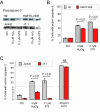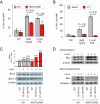Apoptosis resistance in HIV-1 persistently-infected cells is independent of active viral replication and involves modulation of the apoptotic mitochondrial pathway
- PMID: 18261236
- PMCID: PMC2276517
- DOI: 10.1186/1742-4690-5-19
Apoptosis resistance in HIV-1 persistently-infected cells is independent of active viral replication and involves modulation of the apoptotic mitochondrial pathway
Abstract
Background: HIV triggers the decline of CD4+ T cells and leads to progressive dysfunction of cell-mediated immunity. Although an increased susceptibility to cell death occurs during the acute phase of HIV infection, persistently-infected macrophages and quiescent T-cells seem to be resistant to cell death, representing a potential reservoir for virus production.
Results: Lymphoid (H9/HTLVIIIB and J1.1) and pro-monocytic (U1) HIV-1 persistently-infected cell lines were treated with hydrogen peroxide (H2O2) and staurosporine (STS) for 24 h, and susceptibility to apoptosis was evaluated and compared with uninfected counterparts (H9, Jurkat and U937 respectively). When exposed to different pro-apoptotic stimuli, all persistently-infected cell lines showed a dramatic reduction in the frequency of apoptotic cells in comparison with uninfected cells. This effect was independent of the magnitude of viral replication, since the induction of viral production in lymphoid or pro-monocytic cells by exposure to TNF-alpha or PMA did not significantly change their susceptibility to H2O2- or STS-induced cell death. A mechanistic analysis revealed significant diferences in mitochondrial membrane potential (MMP) and caspase-3 activation between uninfected and persistently-infected cells. In addition, Western blot assays showed a dramatic reduction of the levels of pro-apototic Bax in mitochondria of persistently-infected cells treated with H2O2 or STS, but not in uninfected cells.
Conclusion: This study represents the first evidence showing that resistance to apoptosis in persistently-infected lymphoid and monocytic cells is independent of active viral production and involves modulation of the mitochondrial pathway. Understanding this effect is critical to specifically target the persistence of viral reservoirs, and provide insights for future therapeutic strategies in order to promote complete viral eradication.
Figures





References
Publication types
MeSH terms
Substances
LinkOut - more resources
Full Text Sources
Medical
Research Materials

